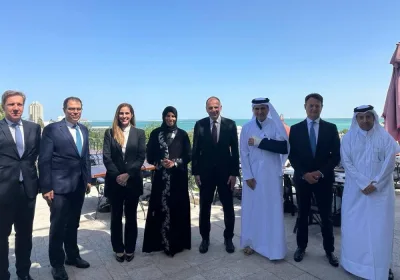Reuters
Qatar’s economy is expected to keep outperforming the other five GCC states with a 6.7% growth rate in 2015, much faster than the 6.0% forecast in April, as the country spends billions of dollars on construction before it hosts the 2022 soccer World Cup tournament, a Reuters poll of analysts showed yesterday.
The higher growth forecast also means, however, that price pressures in the world’s top liquefied natural gas exporter are expected to intensify, taking the inflation rate to 4.0% in 2015 and 4.5% in 2016, the highest among the Gulf countries. “Capital investment into the economy is expanding, population is growing at a double-digit rate and projects are getting fully under way,” said Farah Ahmed Hersi, senior economist at Masraf Al Rayan in Doha. “Despite all of this infrastructure-building activity, the construction inflation in the country is still remarkably low.”
Gulf Arab economies are likely to grow slightly faster in 2015, propped up by strong private business activity despite further falls in oil prices, the poll said.
Brent crude oil, now at just above $96 a barrel, is down almost $20 from June’s peak. Many economists expect the downtrend to continue in coming years, although at a slower pace, because of ample supply.
But the financial positions of most Gulf Co-operation Council governments are expected to stay healthy enough for them to continue spending heavily, while private sector growth may offset any drop in activity in the hydrocarbon sector.
Saudi Arabia’s $748bn economy - the biggest in the Arab world - should expand 4.3% next year, a tad more than the 4.2% rate expected in 2014 and 2016, according to the consensus of 18 analysts polled over the past two weeks.
Both the 2015 and 2016 forecasts for Saudi Arabia’s real gross domestic product growth are unchanged from the previous Reuters poll on the region, conducted in April. “The fall in oil prices to under $100 per barrel is unlikely to knock underlying growth in GCC economies significantly off course,” said Daniel Kaye, senior macroeconomic editor at the Oxford Economics consultancy.
“In most countries, non-oil growth should remain in the 4%-6% range. It is possible, however, that Gulf oil output could be cut more sharply than expected as the Opec leadership looks to provide support to prices.”
In the UAE, where a double-digit jump in Dubai property prices has sparked fears of another bubble, GDP is projected to grow 4.5% next year.
Growth is then expected to slow to 4.3% in 2016, when GCC members are likely to feel the dampening effect of US interest rates, which are expected to start rising in 2015.
Most GCC states peg their currencies to the dollar, meaning they cannot diverge much from US interest rates over a long period, otherwise they risk destabilising capital outflows.
On the fiscal front, prospects are less bright for the GCC economies since years of breakneck government spending have left them requiring higher oil prices to post state budget surpluses.
Sliding oil revenues are bad news for small oil exporters such as Oman, which analysts expect to tip into a budget deficit of 0.8% of GDP in 2015, and Bahrain, which could tumble deeper into the red with a 5.7% gap next year.
Even oil giant Saudi Arabia has seen its fiscal forecasts slashed; it is now expected to post a surplus of 2.0% of GDP in 2015 and just 0.3% in 2016, instead of the 3.7% and 3.5% predicted in the April survey.
“Growing government spending commitments on subsidies combined with high spending on infrastructure and other projects will mean reduced surpluses as oil exports remain stagnant or even contract slightly over the years,” said Oxford Business Group, an economic and business research publishing firm. “By 2016, Saudi Arabia could be at the break-even point or even running a small deficit. But with the conflicts in Iraq, Libya, and Ukraine as well as the deteriorating security situation in Nigeria, oil prices will not fall as much as some expect.”



